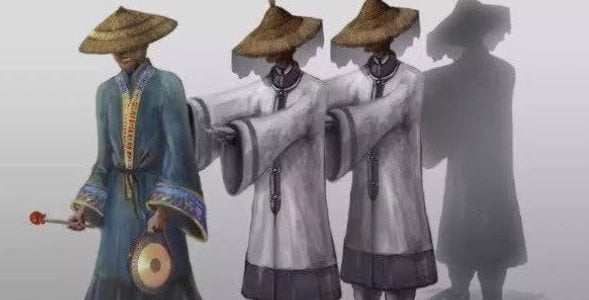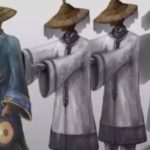The Real Walking Dead

One of China’s most mysterious and off-putting legends is the walking corpses. It was believed that when a family member passed away, they needed to be returned home or their soul would turn into a “lonely ghost” (Youtube, 2015) and would never be released. This belief was exploited and used to start one of the biggest myths in Chinese history. The supposed source of this ritual is not clear. It is thought that because people were not able to afford for their loved ones to be driven home, they hired a priest to have them “walk home” by themselves. The priests would only perform this ritual at night because it was considered to be “bad luck” for a living person to look at a “walking corpse”. This allowed for many people to take advantage of this and made it a very profitable and secretive tradition. The legend of the walking corpses was and still is among some, a very believable legend because it was a secretive, respected, and feared tradition.
The legend of the walking corpses was said to be originated from the Battle of Zhuolu. According to Chinese mythology, the god Chiyou pursued a war against the Yellow Emperor (Woolf, 2007). After this long, bloody battle was over, Chiyou saw the battlefield was covered in corpses. He ordered his adviser to “use his magic and return them home” (Youtube, 2015). The adviser’s ceremony reanimated the corpses and followed him home. This legend is only found in the Xiangxi area. The Battle of Zhuolu is one of the many origin stories that are told about the walking corpses.
The belief of bringing home your loved ones after they passed away was started in Xiangxi by the Miao minority. They believed that if a family member passed away in an unfamiliar land, their soul would turn into a lonely ghost and they would never be released (Youtube, 2015). Xiangxi is extremely mountainous so it is hard to carry a body back home. They couldn’t use chariots or a stretcher to bring them back home so apparently, they used witchcraft to bring home their loved ones. They also had no official records of walking corpses, so the legend was only told verbally. The Miao’s in Xiangxi believed you had to bring home your loved ones after they pass or they would never be at peace.
It is scientifically impossible for a corpse to actually move. In fact, the body loses that flexibility after 20 hours of it passing (Youtube, 2015). This led some people to believe that it had to be done a different way. The secret of the walking corpses had to be some kind of illusion or misconception because it is impossible for it to be legitimate.
In the 1950s, an old report from two soldiers in Lushi might help further explain the existence of walking corpses (Youtube, 2015). While on duty, two plainclothes soldiers saw people walking and wearing black robes and a straw hat. This was extremely suspicious to the soldiers, so they decided to follow them. When the people they were following went into an inn, they asked the owner of the inn about who those people were. According to the inn owner, the people were walking corpses. The soldiers were very skeptical about this idea, so they went to the corpse drivers room and knocked at his door. The corpse driver looked nervous when he opened the door. The supposed “corpses” were against the wall. It was discovered that the “corpses” were actually smugglers. This was one of the many ways this ancient tradition was taken advantage of. The soldier’s discovery revealed one of the many ways this legend was taken advantage of and used for someone’s own benefit.
The walking corpses were very mysterious and scary to the people who knew about them. They thought that it was “bad luck” to cross a walking corpse’s path (Youtube, 2015). This belief made it very easy for smugglers to take advantage of. They could pretend to be a walking corpse and no one would bother them. It was extremely profitable and they had a very low chance of getting caught.
Other than the issue of the corpse not being able to move after its passing, there was questions about how they preserved the body. It can be assumed that it took a long time to bring these bodies back home. The corpse drivers were the people who walked with the corpses. They worked just like farmers, working from dusk till dawn (Youtube, 2015). However, they didn’t like being called corpse drivers. They only dressed up as a “corpse driver” when they were commissioned to. People would ask them to “run an errand”. The corpse driver would write down the deceased name, gender, date of birth, and date of death” (Youtube, 2015) on a piece of yellow paper and would attach it to another piece of paper with incantations on it. After this, he would bring the corpse back home.
Actual corpse drivers did not have an easy job. They preferred working during the autumn and winter because it would help the body stay preserved for a longer amount of time (Youtube, 2015). Even during the winter, the bodies would still start to decompose only after a few days. Since there were no faster ways of transportation, it would take about 10 days to a month to get the body back home (Youtube, 2015). The corpse driver also had to be somewhat fit. They had to be able to carry 40-50 kilograms for long amounts of time (Youtube, 2015). The only issue with this was how the corpses appeared to walk. The corpse drivers had to have another way to make it appear that corpses could walk.
The strange thing about the walking corpses is that they did not appear to walk, they almost looked like they were jumping. This feature was captured in many films, especially in Hong Kong. The corpses would also have their arms stretched out in front of them. The popular assumption was that the corpses jumped around because they could not bend their knees. In 2006, an article posted in a Taiwanese magazine came up with a different explanation (Youtube, 2015). Apparently, the corpses arms were tied to two bamboo sticks, one for each arm. The corpse drivers would hold the bamboo stick from both ends. This gave the illusion of the corpses walking, especially if it was seen at night. Also, the bamboo sticks would make it look like they were jumping because of its flexibility and the weight of the corpses on it. This theory ultimately was not correct.
Another reason the corpses seem to walk is that the corpse driver hides underneath the black robes they are wearing. This made it look like it was actually the corpse walking, when in fact, it was someone underneath holding them up. This was purposefully done to keep up the illusion of a corpse being able to walk. Technically they were being paid to carry home the corpse, but what they were actually carrying was mostly clothes. They only kept the head of the corpse, and threw out the rest of the body. If people knew that this was happening they would be extremely insulted and angry. The way they got around this is that they had very strict rules about viewing the body. The family could only look at the body very briefly before it was put into a coffin. The only thing that would be visible is the head and hands (Youtube, 2015). These rules made people believe that the body came home completely and without harm.
The corpse drivers made a profit of telling people they would have their loved ones walk home by themselves. Their job was also so mysterious, no one wanted to become one. This drastically reduced competition and ultimately made them more profit. They could also ask for higher fees and make even more money. The last records of walking corpses were in the 1950s and is now considered to be a legend (Youtube, 2015). This tradition slowly became irrelevant and is no longer practiced.
The walking corpses was believed for so long because it took advantage of people’s beliefs. It took something so personal and turned it into a business to make profit. The families that used this service believed they were bringing their loved ones back home, when in actuality they were being misled. This legend hid behind people’s fears and respect for the dead. No one would bother them so they were able to keep this business very secretive and mysterious. The walking corpses were a great legend, and it will continue to be remembered for a long time.
References
Greg Woolf (2005). Ancient Civilizations: the Illustrated Guide to Belief, Mythology, and Art. Thunder Bay Press
Guan Hui. John Yong Tao. 湘西赶尸 Origin Of The Chinese Vampire – The Hmong/Miao Walking Corpses.
2015. Youtube. Accessed September 20 2017. https://www.youtube.com/watch?v=Z-tvjjA0VjA







Wow, this article is so interesting. This is the first time I’ve learned about this custom in China and it’s really cultural and historical. From reading your article I found out that any culture has their reasons and we need to respect the different cultures. Good job.